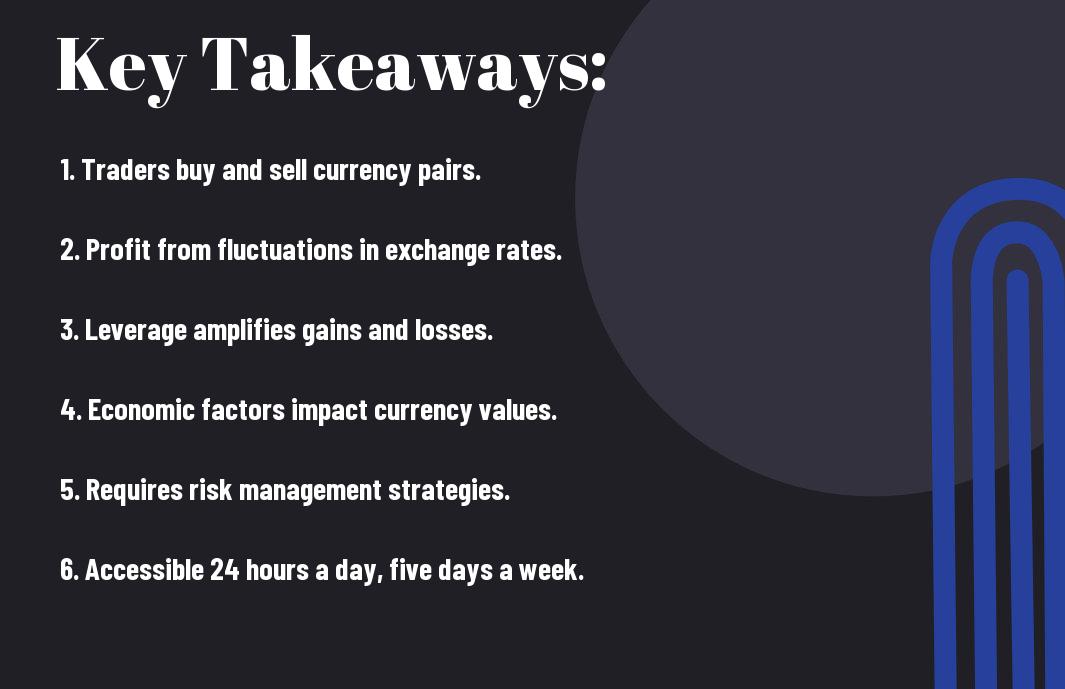Forex trading, also known as foreign exchange trading, involves the buying and selling of currencies in the global market. Understanding how forex trading works is crucial for investors looking to capitalize on the volatility and liquidity of the world’s largest financial market. Traders can profit by speculating on the fluctuations in currency prices, leveraging their positions to amplify gains, but also exposing themselves to significant risks that come with the fast-paced nature of forex trading. It is crucial to grasp the intricacies of how the forex market operates, including factors influencing exchange rates, trading mechanisms, and risk management strategies, to navigate this dynamic and complex environment successfully.
Key Takeaways:
- Forex Market Basics: Forex trading involves buying and selling currencies in the foreign exchange market.
- Leverage and Margin: Traders can use leverage to control a larger position with a smaller amount of capital, but it also increases the risk of significant losses.
- Market Analysis: Traders use technical and fundamental analysis to make trading decisions based on historical price movements and economic indicators.

The Basics of Forex Trading
Forex trading, also known as foreign exchange trading, involves the buying and selling of currency pairs in the global foreign exchange market. It is the largest and most liquid financial market in the world, with a daily trading volume exceeding $6 trillion.
Currency Pairs and Pricing
Any forex trade involves the simultaneous buying of one currency and selling of another. Currency pairs are quoted in terms of one currency against another. The first currency in the pair is the base currency, and the second is the quote currency. The price of a currency pair represents how much of the quote currency is needed to purchase one unit of the base currency.
Market Structure and Participants
Currency trading in the forex market is conducted over-the-counter (OTC), which means that trades are executed electronically between traders around the world, without a central exchange. The market is decentralized, with major participants including central banks, commercial banks, financial institutions, hedge funds, corporations, and retail traders.
Pricing in the forex market is determined by various factors, including supply and demand, economic indicators, geopolitical events, and market sentiment. It is crucial for traders to stay informed about these factors as they can impact currency prices and lead to significant profits or losses.
Fundamental Concepts in Forex Trading
Leverage and Margin
Now, let’s examine into the fundamental concepts of forex trading. Leverage and margin play a vital role in the forex market. Leverage allows traders to control a larger position with a smaller amount of capital. This can amplify both profits and losses. Margin, on the other hand, is the amount of money required to open a position. It acts as a good-faith deposit to ensure you can cover potential losses. It’s important to understand the risks involved with leverage and margin trading.
The Role of Brokers and Trading Platforms
Role in brokers and trading platforms are crucial components of forex trading. This is where traders access the market and execute their trades. Brokers act as intermediaries between the trader and the interbank market, providing access to liquidity. Choosing a reputable broker with a user-friendly trading platform is important for a smooth trading experience. Make sure to consider factors such as regulation, customer service, and trading costs when selecting a broker.
Analyzing and Trading in the Forex Market
Technical Analysis in Forex
All successful forex traders rely on a combination of technical and fundamental analysis to make informed trading decisions. Technical analysis involves studying past market data, primarily price and volume, to predict future price movements. Traders use various tools and indicators to analyze chart patterns and trends, helping them identify potential entry and exit points for trades. It is imperative to understand technical analysis to effectively navigate the volatile forex market.
Fundamental Analysis and Economic Indicators
Fundamental analysis in forex involves evaluating the intrinsic value of a currency by considering various economic indicators, such as interest rates, inflation, unemployment rates, and GDP growth. These indicators provide valuable insights into the overall health of an economy and can influence the strength or weakness of a currency. Traders closely monitor economic data releases and central bank announcements to anticipate market movements and adjust their trading strategies accordingly.
Understanding economic indicators and their impact on currency values is crucial for successful forex trading. Traders must stay informed about global economic developments and be prepared to react swiftly to unexpected news that can trigger significant market volatility.
Risk Management in Forex Trading
Developing a Trading Plan
Plan Unlike gambling, successful forex trading requires a well-thought-out plan. A trading plan outlines your trading strategy, including your goals, risk tolerance, and entry/exit points. It helps you stay disciplined and avoid making impulsive decisions based on emotions. Your trading plan should be based on thorough research and analysis to increase your chances of success in the forex market.
Understanding and Managing Risk
For Forex trading involves significant risks due to the volatile nature of the market. To safeguard your investment, it is crucial to understand and manage these risks effectively. Managing risk in forex trading includes determining the amount of capital you are willing to risk on each trade, setting stop-loss orders to control losses, and diversifying your portfolio to spread risk. By implementing effective risk management strategies, you can protect your investment and increase your chances of long-term success in forex trading.
With a focused approach on risk management, traders can minimize the impact of sudden market movements and protect their trading capital. Emotions like fear and greed can often cloud judgment, leading to impulsive decisions that result in significant losses. By setting clear risk management guidelines and sticking to them, traders can mitigate potential losses and ensure a more consistent approach to trading.
Final Words
Considering all points, it is clear that forex trading operates on the simple concept of buying one currency while simultaneously selling another. Traders aim to profit from changes in exchange rates by speculating on the direction in which a currency will move in relation to another. This market operates 24 hours a day, five days a week, enabling traders to take advantage of constantly fluctuating exchange rates. Through the use of leverage, traders can amplify their potential profits, but this also comes with increased risk. It is important for traders to thoroughly understand the market dynamics, keep up with global economic news, and constantly evaluate their strategies to succeed in the world of forex trading.
FAQ
Q: What is forex trading?
A: Forex trading, also known as foreign exchange trading, is the process of buying and selling currencies on the foreign exchange market. It is a decentralized global market where all the world’s currencies trade. Forex trading is done over-the-counter and operates 24 hours a day, five days a week.
Q: How does forex trading work?
A: Forex trading involves the simultaneous buying of one currency and selling of another. Currency pairs are quoted in terms of one currency against another. For example, the EUR/USD currency pair represents the euro against the US dollar. Traders aim to profit from changes in exchange rates by speculating on whether a currency will rise or fall in value.
Q: What are the key factors that influence forex trading?
A: Several factors can influence forex trading, including economic indicators, geopolitical events, central bank policies, and market sentiment. Economic indicators such as GDP growth, employment rates, and inflation can affect a country’s currency value. Geopolitical events, such as elections or geopolitical tensions, can also impact currency prices. Central bank decisions on interest rates and monetary policies can have a significant influence on currency movements. Market sentiment, based on traders’ perception of the market, can also drive currency fluctuations.
